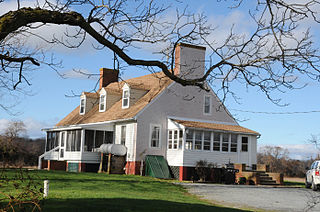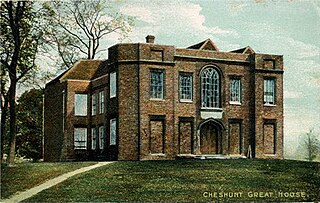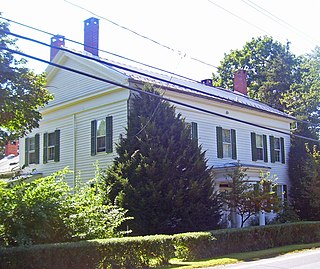This article contains too many or overly lengthy quotations .(December 2024) |

Noxon House is an historic Georgian residence in Poughquag in Dutchess County, New York. Built in 1770 by Benjamin Noxon (born 1745), it stands along the Old Upper Road.
This article contains too many or overly lengthy quotations .(December 2024) |

Noxon House is an historic Georgian residence in Poughquag in Dutchess County, New York. Built in 1770 by Benjamin Noxon (born 1745), it stands along the Old Upper Road.
Noxon House has a brick exterior, hipped roof, square, symmetrical rectangular shape, paneled front door at center decorative windows and elements on either side over front door, five double hung sash windows across the second floor front and four on the first floor, four and four paired chimneys. It preserves a typical Georgian floor plan inside, with four over four and a center staircase ascending, another staircase descending behind it to the lower level and what was the original kitchen for the house. That kitchen still retains a beehive bread oven, large fireplace and original fittings, panels and beamed ceiling. Throughout, the Noxon House preserves its original wide plank floors, original windows and glass panes, many original moldings and doors, eight fireplaces with original surrounds and mantels and original timbers and beams.
The house is mentioned in travel accounts from the early nineteenth century.
The old Poughquag Tavern, (now the residence of Daniel Thomas, Esq.) though of not so ancient origin as those just mentioned, yet may well claim mention here. It was built about the year 1800, by Henry Brill. It was afterwards considerably remodeled, but the front appearance is much the same as it was originally. This was the "half-way house" for the line of stages, running between New Mildorf and Poughkeepsie, and was well patronized by travelers and drovers. Its upper room has often resounded to the tread of the "light fantastic toe," and the loungers of the bar-room as often regaled with travelers' stories, for which the hardy adventurous life of those early times afforded abundant material. The Noxon house, built about the same time, was erected by Benjamin Noxon; and a portion of the brick of which it is constructed was manufactured on the farm on which it stands. It is rapidly falling into decay, and will soon be numbered among the things that were. The Beekman Cemetery is pleasantly located on the southern and western slope of a gentle eminence, north of the village of Poughquag. It is tastefully laid out, and decorated with evergreens, which mingling with the pure white marble of the numerous monuments and headstones, produce a pleasing effect.
— [1]

The Joseph F. Glidden House is located in the United States in the DeKalb County, Illinois city of DeKalb. It was the home to the famed inventor of barbed wire Joseph Glidden. The barn, still located on the property near several commercial buildings, is said to be where Glidden perfected his improved version of barbed wire which would eventually transform him into a successful entrepreneur. The Glidden House was added to the National Register of Historic Places in 1973. The home was designed by another barbed wire patent holder in DeKalb, Jacob Haish.

Kenworthy Hall, also known as the Carlisle-Martin House, Carlisle Hall and Edward Kenworthy Carlisle House, is a plantation house located on the north side of Alabama Highway 14, two miles west of the Marion courthouse square. It was built from 1858 to 1860 and is one of the best preserved examples of Richard Upjohn's distinctive asymmetrical Italian villa style. It is the only surviving residential example of Upjohn's Italian villa style that was especially designed to suit the Southern climate and the plantation lifestyle. It has a massive four-story tower, windows of variable size and shape with brownstone trim, and a distinctly Southern division of family and public spaces. The building was designed and constructed for Edward Kenworthy Carlisle as his primary family residence and the centerpiece of his 440-acre (1.8 km2) estate. It, along with some of its surrounding ancillary structures, was declared a National Historic Landmark in 2004. The house and a purported ghost are featured as a short story in Kathryn Tucker Windham's 13 Alabama Ghosts and Jeffrey.

The William S. Simmons Plantation, also known as the Wesley House, is a Greek Revival brick home located in Cave Spring, Georgia, United States, North America. The home was built in the 1840s, prior to the American Civil War, and was listed on the National Register of Historic Places in 1980.

Bachelor's Hope is a historic house in Centreville, Maryland. Built between 1798 and 1815, it was added to the National Register of Historic Places in 1984.

Stoneacre is a small National Trust property in Otham, near Maidstone, Kent in southern England. The property is a half-timbered yeoman farmer's house dating from the 15th century, together with a small garden, orchard and meadows. The house is a Grade II* listed building.

Tulip Hill is a plantation house located about one mile from Galesville in Anne Arundel County in the Province of Maryland. Built between 1755 and 1756, it is a particularly fine example of an early Georgian mansion, and was designated a National Historic Landmark in 1970 for its architecture.

The Suntop Homes, also known under the early name of The Ardmore Experiment, were quadruple residences located in Ardmore, Pennsylvania, and based largely upon the 1935 conceptual Broadacre City model of the minimum houses. The design was commissioned by Otto Tod Mallery of the Tod Company in 1938 in an attempt to set a new standard for the entry-level housing market in the United States and to increase single-family dwelling density in the suburbs. In cooperation with Frank Lloyd Wright, the Tod Company secured a patent for the unique design, intending to sell development rights for Suntops across the country.

Cheshunt Great House was a manor house in the town of Cheshunt, Hertfordshire, England, near to Waltham Abbey. It is said to have been built by Henry VIII of England for Cardinal Thomas Wolsey. The family seat of the Shaw family for over a century, by the late 19th century it was used as a Freemasons Hall and was later used during World War II. After the war, the hall was too costly to run and was opened to the public until a fire gutted it in 1965. It had been made a Grade II listed building on 11 June 1954.

The Stephen Hogeboom House is located on NY 23B in Claverack, New York, United States. It is a frame Georgian-style house built in the late 18th century.

The Stephen Storm House is located on the NY 217 state highway just east of Claverack, New York, United States. It is a Federal style brick house built in the early 19th century.

Hearthstone Castle in Danbury, Connecticut, was built between 1895 and 1899. It was listed on the National Register of Historic Places in 1987. It has also been known as Parks' Castle and as The Castle. The property includes four contributing buildings and three other contributing structures. Today, the castle is owned by the City of Danbury and is located in Tarrywile Park. Hearthstone Castle is slated to be renovated into an observation deck.

The Ezra Clark House is located on Mill Road in the Town of North East, New York, United States. It is a brick house built in the late 18th century.

The Edward Salyer House is located on South Middletown Road in Pearl River, New York, United States. It is a wood frame house built in the 1760s.

Benjamin Riegel House is a historical home built in 1832 in Riegelsville, Pennsylvania in the Lehigh Valley region of eastern Pennsylvania.

The Golden Lion is a pub in Fulham, in the London Borough of Hammersmith and Fulham, London, England. It is located on Fulham High Street, to the east of Fulham Palace Gardens. Built in 1455 it is reported as the oldest pub in Fulham and was rebuilt by one of its Victorian owners. Notable patrons include the playwrights Shakespeare and Fletcher as well as Bishop Bonner.

Mansion House is a prominent and historically significant Grade II* listed Georgian village property in Hurstpierpoint, West Sussex, England. The substantial family home is situated in the heart of Hurstpierpoint with the High Street at the front and South Downs to the rear. The brick-faced, timber-framed building has surviving medieval sections dating back to the mid- to late 16th century.

Lenhart Farmhouse is a historic farmhouse in Root Township, Adams County, Indiana. It was built about 1848, and was listed on the National Register of Historic Places in 2002.

United Service Club Premises is a heritage-listed club house at 183 Wickham Terrace, Spring Hill, City of Brisbane, Queensland, Australia. It was designed by architect Claude William Chambers and built from 1906 to 1947. It is also known as Montpelier and The Green House. It was added to the Queensland Heritage Register on 28 April 2000.

Penrhyn is a heritage-listed detached house at 103 Limestone Street, Ipswich, City of Ipswich, Queensland, Australia. It was designed and built by John Farrelly c. 1879. It was added to the Queensland Heritage Register on 21 October 1992.

Clydebank is a heritage-listed residence at 43 Lower Fort Street, in the inner city Sydney suburb of Millers Point in the City of Sydney local government area of New South Wales, Australia. It was built from 1824 to 1825 by Robert Crawford. It is also known as Bligh House, Holbeck and St Elmo. It has also served as an art gallery and as offices in the past. It was added to the New South Wales State Heritage Register on 2 April 1999.